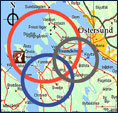

 |
SaTScan™ Software for the spatial, temporal, and space-time scan statistics |  |
|
SaTScan Related SoftwareThere are a number of other software packages that are related to the SaTScan software. These include (i) wrappers and macros, whereby SaTScan can be run as part of another software environment such as SAS or R, (ii) software that calls and uses one or more SaTScan features as an integral part of the software, (iii) programs for displaying SaTScan results using the SaTScan output files, (iv) independent implementations of the SaTScan spatial and space-time scan statistics, and (v) software for other types of scan statistics not covered by SaTScan. Some of these programs were developed as part of a SaTScan project, in collaboration with the SaTScan development team, while other programs are completely independent creations. SaTScan Wrappers and MacrosR Package ‘rsatscan’: A wrapper for running SaTScan as an R packageThe rsatscan package consists of Tools, Classes, and Methods for Interfacing with SaTScan Stand-Alone Software. It provides functions for writing R data frames in SaTScan-readable formats, for setting SaTScan parameters, for running SaTScan in the OS, and for reading the files that SaTScan creates.
The HTML files below demonstrate how to use the rsatscan package with SaTScan. They closely resemble the vignettes distributed with the rsatscan package, but include SaTScan results, which are omitted from the official vignettes for CRAN policy reasons. The R files contain the R scripts used.
A SaTScan Macro Accessory for Cartography for the SAS EnvironmentThe SaTScan Macro Accessory for Cartography (SMAC) package consists of four SAS macros and was designed as an easier way to run SaTScan multiple times and add graphical output. The package contains individual macros which allow the user to make the necessary input files for SaTScan, run SaTScan, and create graphical output all from within SAS software. The macros can also be combined to do this all in one step.
Daily Reportable Disease Spatiotemporal Cluster Detection - SAS MacrosEach day, the New York City Department of Health and Mental Hygiene uses the free SaTScan software to apply prospective space-time permutation scan statistics to strengthen early outbreak detection for 35 reportable diseases. This method prompted early detection of outbreaks of community-acquired legionellosis and shigellosis.
SaTScan Integrated Within Other SoftwareWHONet SoftwareWHONet is a free windows-based database software developed for the management and analysis of microbiology laboratory data with a special focus on the analysis of antimicrobial susceptibility test results. The software has been developed since 1989 by the WHO Collaborating Centre for Surveillance of Antimicrobial Resistance based at the Brigham and Women's Hospital in Boston, and is used by clinical, public health, veterinary, and food laboratories in over 90 countries to support local and national surveillance programs. SaTScan has been incorporated in WHONet for purpose of the early detection of anti-microbial resistance outbreaks.
Prepare SaTScan Input DataGeographic Aggregation ToolSaTScan is best run on as fine a geographical resolution as available. An exception to this is when there are close to a million or more geographical location, in which case to computational burden may become to high. Health outcome maps with fine geographic resolution may also inadvertently disclose confidential data. To overcome either of these problems, the New York State Department Geographic Aggregation Tool joins neighboring geographic areas together until a user defined population and/or number of cases is reached. The tool is available in R or SAS.
Independent Implementations of Spatial and Space-Time Scan StatisticsThe statistical methods in SaTScan were developed by Martin Kulldorff and his colleagues. Some of these methods have also been implemented in other software as part a set of different spatial techniques. R Package ‘SpatialEpi’: Methods and Data for Spatial EpidemiologyThis R package contains a function called kulldorff, which performs the purely spatial scan statistic with either the Poisson or Bernoulli probability model. The package also contains many other useful methods that are unrelated to scan statistics and not part of the SaTScan software.
ClusterSeer: Software for the Detection and Analysis of Event ClustersThe windows based ClusterSeer software contains 24 different statistical methods for detecting and/or evaluating spatial, temporal and space-time clustering, including Kulldorff's Spatial Scan for purely spatial Poisson data and Kulldorff's Scan for space-time Poisson data.
Software with Other Types of Scan StatisticsTreeScan: Software for the Tree-Based Scan StatisticDeveloped by the same team as SaTScan, TreeScan™ is a free data mining software that implements the tree-based scan statistic, a data mining method that simultaneously looks for excess risk in any of a large number of individual cells in a database as well as in groups of closely related cells, adjusting for the multiple testing inherent in the large number of overlapping groups evaluated. Developed for disease surveillance, it can be used for post-market drug and vaccine safety surveillance as well as occupational disease surveillance.
FlexScan: Software for the Flexible Scan StatisticLike SaTScan, the FlexScan software is designed for the detection and evaluation of purely spatial disease clusters. Unlike SaTScan, it uses a non-parametric rather than circular or elliptic definition of clusters, but it also includes the circular as a special case.
|
